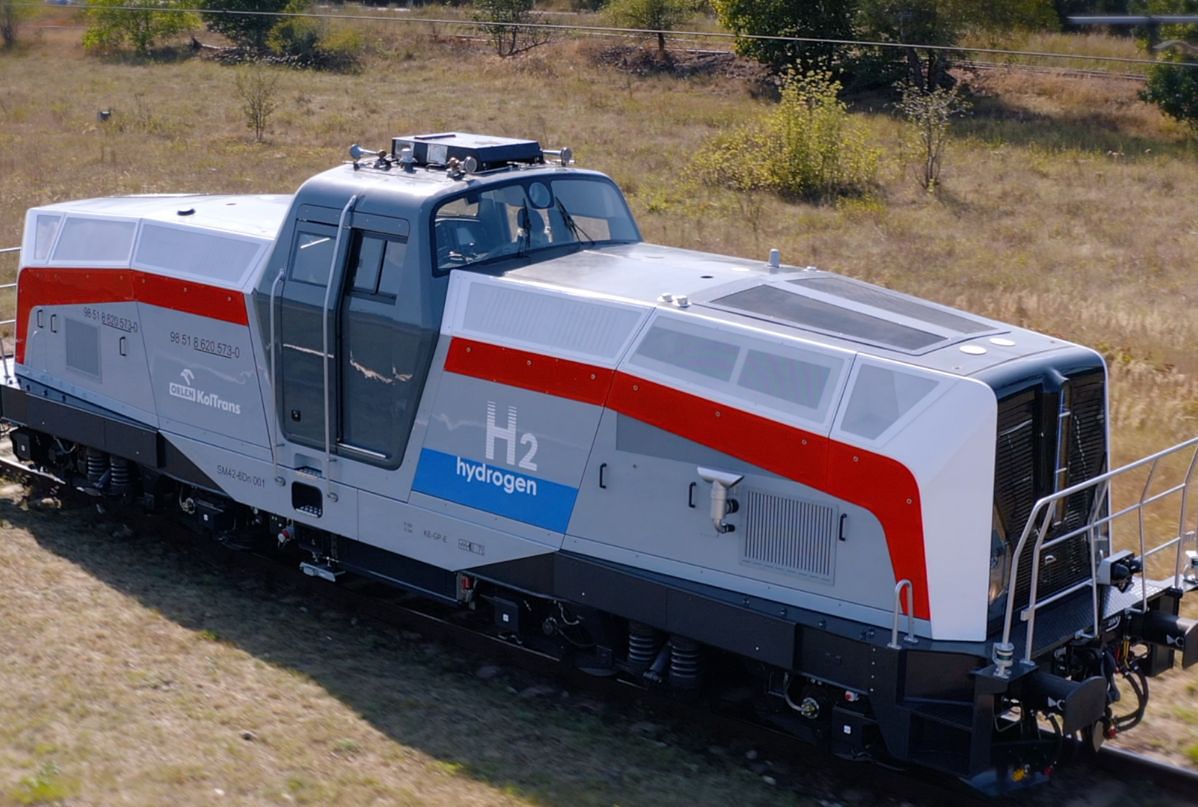First hydrogen locomotive started working in Poland.
Imagine if we somehow could run trains on electricity, that would be even better
They already do, they just have a diesel generator to make the electricity
Guessing that replacing that with a large battery that charges at night is unreasonable due to the torque needed? You’d probably need a battery larger than a train engine to be able to even do a few stops and starts. Which is why electric trains are wired all the time.
If someone knows for sure I’m super curious!
This is exactly what I was looking for, thank you!
Is this whole thread a joke or have you people not heard of electrified rail
I mentioned it in my comment that you’re replying to. “wired” could easily refer to above or below, just continuous current is what matters for this discussion. Why do ask?
Edit: Wait did you think we can electrify all rails? Outside of major cities it’s a maintenance and safety nightmare, and a LOT of our freight moves via rail.
Global warming is a major maintenance and safety nightmare outside and inside major cities.
There are trains available that will run on overhead lines where available, and diesel when they’re not. There’s also passenger trains that have batteries as well.
It’s doable, especially considering how efficient trains are.
It’s kinda the default actually. Locomotives might lack pantographs if they never see electrified track but diesel locomotives aren’t direct drive but diesel-electric. I’m not that deep into the topic but from what I’ve heard a mechanical transmission would be a nightmare.
Modern trains are almost exclusively electric final drive, off the top of my head I can’t think of any exceptions. There are so many different voltages of overhead pantographs and drive motors though, there is almost always some type of converter needed to provide the right voltage to the drive motors.
Wait did you think we can electrify all rails?
You can electrify your rail because that’s what we did.
Outside of major cities it’s a maintenance and safety nightmare
No. Also outside of city cost of electrification is much cheaper.
and a LOT of our freight moves via rail.
Same for me
Not sure where you’re from but if you pretend it’s Switzerland then this comment is for you https://reddit.com/r/trains/s/UE3DSOPUdf
Not Switzerland, Russia
The problem with battery trains is that locomotives hardly sit around long enough to charge unless it’s some sort of switcher or in for maintenance. Really the only use case for battery locomotives outside of switchers is passenger service where it’s fairly common for a train to sit for eight plus hours. Amtrak and Siemens are actually doing this with 15 of the new airo trainsets which will run on the empire line. The trainsets will specifically run on battery while within the new York city tunnels where diesel locomotives are only allowed to operate under emergency.
There is probably a use for train with battery on partially electrified lines.
The train charge on the electrified part and use batteries on the rest.
It’s definitely a thing already.
Trains are already pulling what 100 cars. It’s easy enough to have a car that’s a battery. But I think overhead lines are the way to go on the vast majority of lines.
For transport of people, it seems germany has some train with battery. They replace their hydrogen trains.
deleted by creator
Supercapacitors.
If I ran the local power grid I’m not sure I’d want cargo trains using line power for traction, unless there was some mandated weight or length limit 🤔
Without some cargo limit I think sections of the line’s voltage will just collapse under the current being drawn, whenever the cargo train moves off from a complete stop - especially if it’s a multi mile long cargo train that seems common in the US
The Kiruna - Narvik electrified line is operating just fine with LKAB running the heaviest trains in Europe with a mass of 8600 tonnes.
90% off the cargo trains are powered with electricity in France and can reach up to 750m.
I agree It’s not multi mile long but it’s totally possible to have electric cargo trains.
There’s little chance of that happening, but even if there was, they’d just use batteries for the acceleration phase. That’s what hydrogen fuel cell trains do anyway, because the fuel cell can’t produce enough power on it’s own to accelerate the train from a stop, so they’re used to charge batteries that allow it to do so.
The reason why there’s little chance of that happening is there are already very many cargo trains powered by overhead lines. We’ve been doing it for 150 years and in continental Europe there are many sections of track that are entirely electrified because it made more economic sense than running a wasteful (compared to a steam power plant) diesel generator to power the already electric engines of the trains.
I really can’t see a train pulling so much that it crashes the entire system. *When you think about it it’s one (moderate size) generators worth.
Without some cargo limit I think sections of the line’s voltage will just collapse
I think this guy never learned about resistance. Maybe he skipped physics classes, maybe he didn’t even have them yet.
Would you ellaborate on what you mean, and the assumptions you drew from the quoted text?
Even better, we could also put cables above the train and connect them to an even bigger diesel generator located somewhere close to the railway. That would make the locomotive lighter and the energy production more efficient. Better yet, replace the diesel with uranium and you can easily power many trains.
That would make the locomotive lighter
That’s not an advantage. You want your loco to be as heavy as possible for traction. If they were switching it to pantograph and it was lighter they’d add iron, or something else to make up the difference
You want your loco to be as heavy as possible for traction.
I see you don’t know why Caucasus was electrified. Non-electric locomotives were just too heavy and couldn’t lift as much as mass as electric could.
 Show me disel here
Show me disel here
I don’t know about Poland but I know about France (I would guess we’re not so far appart on this point).
While 95% of railways are electrified, those last 5% are not very worth it to invest in, because really low traffic and hard to operate (eg. in mountains). I’ve already heard of compromises, like hybrid locomotives that can run on battery for more than half the line and rely on diesel for the remaining.
hard to operate (eg. in mountains).
In Soviet Union Caucasus was electrified first for this exact reason. Without electrification it was too hard to operate.
all trains, even the speed trains, in france run on electricity for who knows how many decades.
same trains go to great Britain, Belgium, Netherlands, Germany and maybe some other countries too.
source of the electricity is debatable though. France produces a great majority of its electricity from nuclear since the ww2 trauma.
Oh you mean debatable because it’s one of the cleanest, cheapest, and safest sources of electricity we have?
Which allows France a degree of energy independence which has helped it not suffer the same amount of pain other countries have now that they’re having to kick the cheap Russian gas addiction?
And through huge cross-border interconnects it allows France to sell electricity to neighbouring countries at a huge profit?
Nuclear is not always the answer, but as France has shown, as long as you invest in reliable infrastructure and don’t put it in earthquake/tsunami-prone areas, it can be a huge positive for your country.
And you don’t have to rely on antagonistic petrostates for to power your homes with gas, or on strip-mining huge swathes of land by equally-antagonistic China for rare-earth metals for your wind turbines/solar panels/battery storage.
by “debatable”, i mean that the moment you mention it, debate starts. You proved me right and i thank you 😉
i think controversial fits it better
if you say so
Not trying to start a fight or anything, but don’t we still ‘need’ to burn a lot of coal to fuel electricity? Renewables haven’t gotten close to pushing the necessity of coal away yet, no? Why not alternatives like this in some places to offset the need for electricity?
Hydrogen doesn’t exist randomly in a well or something it has to be created by using electricity - and that transformation is very inefficient if you then use the hydrogen in an inefficient way to power an engine instead of just using the electricity directly
That argument that energy is coal-heavy actually counts against hydrogen…
Hydrogen powered stuff only makes sense when electric isn’t an option like for planes that just can’t carry heavy batteries
Apparently, some hydrogen does come out of the ground like methane: https://www.weforum.org/agenda/2023/09/white-hydrogen-deposit-france/ but I assume it’s not abundant enough to make a difference
You don’t have to use electricity to make hydrogen! You can make it from methane! But yeah, it’s probably even worse than a diesel engine when it comes to CO2 emissions…
While it technically doesn’t you “need” electricity, Methane Pyrolysis requires energy of some sort.
Nuclear is the energy source that scares everyone but that is actually the most viable option to power the world until renewable becomes the dominant one.
Thorium has been the best solution all along but it can’t be weaponized so countries have been ignoring it for decades until recently
The issue to me in term of effeciency is that the production of hydrogen needs electricity, the movement of it needs electricity, the storage and pumping of it needs electricity, and so on. I’d rather see all that electricity in the process simply be moving the vehicle. Though lugging batteries along is an issue in it’s own.
What about wire?
What about it?
While it may not be the best option, is it not good that somewhere is at least trying it?
As long as it’s not widespread adoption, it seems like a good idea to at least trial these sort of things on a small scale to properly determine the real world application, even if the conclusion is just “yeah, it shit”.
No! If it doesn’t immediately solve the issue completely without any drawbacks it must be scrapped and no one should work to improve it!
Best regards,
Every conservative party (and their corporate sponsors).
Most of the supporters of hydrogen trains are the Oil & Gas lobby, a traditionally conservative group. It’s another, “Technology will save us from climate change!” scheme, which will allow unabated oil extraction to continue so we can make hydrogen fuel.
If I may?
Hydrogen, green hydrogen, can be produced from water, using electricity produced from renewables, like solar amd wind.
My own country is in the process of converting a decomissioned refinery into a hydrogen plant.
It may not solve much in the short term but as an energy reserve, hydrogen can find use directly as a fuel or for running gas turbines to produce electricity in replacement of conventional gas.
Green Hydrogen from Electrolysis is extremely inefficient (<30%). Renewable energy isn’t without cost or environmental impact, so we need to responsible with how we use it. Unless the grid you’re pulling from is 100% renewable and has excess power that is just being wasted, that renewable energy could be used elsewhere in a more efficient manner.
Siemens quotes 80% for their electrolysers, fuel cells run at about 60%… in steel smelting if you squint right over 100% (reducing directly with electricity is possible, but less efficient in practice than going via hydrogen). Similar for chemical feedstock where “just use electricity bro” really isn’t an option in the first place.
Precisely because of those uses hydrogen (and by extension ammonia) will be a massive energy carrier in the future anyway. And both, and definitely ammonia, doesn’t self-discharge, or have cycle life limitations.
Regardless, it is a start. Unless we are to stumble upon the secret of cold fusion, we need to compromise in order to make any kind of move away from fossil energy.
The project I mentioned is to be a self contained system, reliant on renewables only, hence the green classification.
but it’s not either /or is it? there places where overhead cables are not a good option for trains so a Hydrogen train makes sense there it’s a niche but it’s use case is there
It can be made from water and renewables at about 3-4x the energy cost of charging a battery. In train terms, that means you could be charging 3 battery trains instead of 1 hydrogen train. Or you could have 3 battery tenders and have more logistical flexibility in how they are deployed.
To what I know, the hydrogen to be produced is intentended to replace fossil gas in northern europe countries. It’s meant to be a stockpileable energy resource.
It’s not ideal but we either make middle of the road commitments and actually get something done to move forward or just call it all off an let things fizzle out
Unless someone figures a way to sequester hydrogen into an inert, reversible form you really don’t want to be stockpiling hydrogen for obvious reasons.
It’s not like we have had disastrous events related to hydrogen.
The objective is to built a trans-iberian pipeline for the liquified hydrogen. So, it will be interesting.
And this is exactly the case here. This train is being trialed by an oil subsidiary. They’ll greenwash it, proclaiming “nothing comes out of our train but water!”, neglecting the fact the hydrogen was made from fossil fuels.
This train is being trialed by an oil subsidiary so I think there is more than a little greenwashing going on here. The vast majority of hydrogen is “blue”, i.e. it’s manufactured from fossil fuels, so there is no environmental benefit to this. Even if it were “green”, i.e. made from water and renewable energy, the same power used to make the hydrogen, store it, transport it, turn it back to power could charge 3 or 4 battery powered trains or tenders - a tender could mean a smaller locomotive hooks up to however many battery tenders it needs for its route or switches them out in the yard.
Honestly all this feels like the railway’s Dieselization 100yrs ago. When the end of steam powered engines was drawing near, coal hauling railroads and Baldwin Locomotive in the U.S. tried all kinds of whacky and hilariously inefficient engine designs, just to keep the ol’ ways alive… none of these worked out - everyone who stuck to it lost hugely. Viz. https://en.m.wikipedia.org/wiki/Chesapeake_and_Ohio_class_M-1
The environmental benefit of blue hydrogen is that it doesn’t put CO2 into the atmosphere. This is better than burning the hydrogen carbon gas it was produced from.
Except it does. This study suggests that the plants that produce hydrogen from fossil fuels are only capturing 80% of the CO2. So 20% is emitted. And aside from that hydrogen has the potential to contribute 12x as much to global warming as CO2 emissions.
That statement is correct, but you are still wrong. Blue Hydrogen specifically refers to hydrogen produced fron fossiles where the CO2 is captured. There is just very little blue Hydrogen being made from fossiles- most production is either grey Hydrogen (from gas no capture) or brown (same but coal).
Hydrogen probably has some niche uses but there are some things that proponents like to gloss over.
- It’s not green since most of it is produced from fossil fuels. It’s also disgustingly expensive even compared to fossil fuels. I’d note that the company Orlen Koltrans which is funding this train is a subsidiary of an oil company PKN Orlen so yeah.
- Even if it were green (e.g. water electrolysis from renewables) it takes something like 3-4x the energy to produce, store, transport, and convert back to energy as just charging a battery.
- Regardless of how it’s made hydrogen also contributes to global warming - if any hydrogen leaks or escapes during fueling or venting, it promotes the methane production in the atmosphere.
- It can and does go kaboom. e.g. this hydrogen powered bus has seen better days.
All said and done, I think it’s crazy to even bother with the tech unless its so niche it cannot be done some other way. Japanese automakers & oil companies looking to do a bit of greenwashing have been the major proponents of hydrogen and that should say something. Also the fact that hydrogen has been a miserable failure in areas where it has been piloted.
In the case of trains it seems more sensible to manufacture biodiesel or synthetic fuels than this. It’s certainly safer to transport and store. Perhaps existing trains can be converted relatively easily. Or electrify the train line or stretches of it. Batteries would be an option too - a train might simply hook up to a fresh battery tender and off it goes. Or some kind of hybrid solution that can source power from overhead lines and/or diesel and/or battery. Or even put solar on carriages to reduce fuel consumption during daylight operations. All these things seem more viable than hydrogen.
Biodiesels arent more efficent, a huge waste of land and destroying the local environment through monocultures, pesticides and fertilizers.
The most reasonable solution would be to fucking electrify the train tracks. It is a train god dammit. It runs on tracks and the track aint running anywhere else.
Biodiesels are still better than diesel and the stuff can be manufactured from seaweed, algae, any biomass really. It doesn’t have to be a monoculture. It doesn’t even have to be 100% biodiesel either - start blending it in. I agree electric motors and electrification are the ultimate outcome but the rail industry has a lot of lines and a lot of locomotives and and you want progression over time with options for battery, power lines or diesel, potentially all 3 on the same line in different parts. It might take decades to transition. It’s certainly not hydrogen, that’s for sure.
In support of your point, and to help clarify it, there’s a lot of train lines where the cost (and the carbon output) of electrification is far beyond the benefit. A lot of the North Wales coast, for example, because working in the tunnels would be prohibitively expensive. In these cases it makes sense to have bi/trimodal trains, at least until electrification technology makes significant breakthroughs.
Another example might be cases where an old rail line (e.g. ex-mining) is looking at being reopened at a low capacity. It would be madness to immediately electrify. An example I have looked at was running a train for tourists on what is currently a little-used freight line (that still uses tokens!) in the Lake District.
A whole lot of misinformation about biofuel here. Manufacturing biofuels does not require significant changes to current agriculture practices. Most biofuel is made from byproducts that would be burned as waste otherwise.
That is wrong already. Land use for biofuels
But it would get even worse, when we’d expand the land use even further by raising the demand significantly.
Two things: We’re already talking apples and oranges because I’m talking about biofuel production in the United States (the world’s largest producer of biofuel) and you’re talking about Europe.
Secondly, I’m talking about increasing the production of second-generation biofuels (cellulosic biofuel) which can be made from byproducts and green waste.
I am in favor of electrifying transportation networks in ways that do not require battery energy storage. However, no discussion about reducing reliance on fossil fuels, in particular when it comes to personal transportation, is honest if it does not account for the incredible environmental damage caused by the extraction of materials for and manufacturing and disposal of lithium batteries. Hydrogen power isn’t a direct burning of hydrogen as a clean fuel, it works by generating electricity to charge lithium batteries, which are then discharged to power electric motors.
Additionally, there is not enough lithium in the earth to sustainably replace carbon fuels for transportation. Renewable biofuels, combined with a reduction or cessation of the use of fossil fuels and an increase in clean nuclear energy are a much more likely and rational solution for the transportation energy problem.
deleted by creator
I can appreciate the electrification push for passenger vehicles. Good luck moving frieght with electric.
I fail to see the problem? Freight trains in Europe regularly run electrical already. There is no technological reason as to ehy they shouldnt or couldnt be electrified.
And if you want to go to mountain area, then electric is your only option
RTFM. EMUs are more capable than DMUs.
- Green hydrogen is being produced at scale.
- So what, renewables are infinite
- That’s overblown
- You think the toxic (deadly) lithium thermal runaways that can’t be stopped are somehow better? No. They are worse and a deadly underground carpark disaster waiting to happen.
- Not enough lithium in the world to supply the global suv market let alone compete with other markets and let’s not forget that the rest of the transport market…Lithium batteries are yet again another finite mined resource with the same problem as dinosaur juice.
- Rail lines won’t be electrified, they are barely being maintained as is!
You think the toxic (deadly) lithium thermal runaways that can’t be stopped are somehow better? No. They are worse and a deadly underground carpark disaster waiting to happen.
Yup, all those trains waiting to explode in carparks. Nor are we developing better batteries that don’t have these problems. Nope, just leaving things exactly as they are.
Not enough lithium in the world to supply the global suv market . . .
Even if lithium was our only battery option, this is just plain wrong. People misunderstand what “reserve” means in mining. It’s not the amount of something that’s available to be mined. It’s the amount that is available profitably under current economic conditions. Both better technology and other shifts in the market mean more reserves “magically” open up.
Oceanic lithium mining may already been commercially viable, and the amount of lithium we can get from that is basically unlimited. On the lab side, there’s a promising string-based evaporation method, which would substantially reduce costs and environmental footprint–exactly the sort of tech that makes more reserves open up. It still needs to be demonstrated at scale, but the strings involved don’t use any exotic materials or have any difficult production.
I wish they gave a $ per KG estimate in your link about harvesting with strings. The methods detailed in this Journal article gives estimates of $2-5 per KG which is like a 5 to 12x return at current prices.
I wonder if you could couple that string method with desalination plants? Take the brine output, extract the lithium with the string method before releasing back into the ocean. Two birds one stone sorta deal. I also wonder if the string method is as technically easy to implement and separate the end products, and it’s just a lot of labor if this will end up economically benefitting countries with extremely low wages. If so, that could be ecologically very bad, especially if it’s possible to do with salt water brine. (As it could incentivize people to pump ocean water inland to make brine pools for harvesting).
The fact you couldn’t put the recent derailments and toxic unstoppable fires together shows clear ideological bias.
“Developing” cool so 5 years? 10 years? For these super safe “in-development batteries”. Neat. More clear ideology borderline fantasy.
“Reserve” Hahahaha More fantasy. Demand has never been higher but don’t worry. “Reserve” will save us all…
“Other technology” “Profitability “ hahaha good god how much of a fantasy are you selling.
- Not really. There are plans for hydrogen plants. The vast majority is “blue”. Secondly what are the chances that an oil company is going to make green hydrogen?
- The renewables aren’t the problem. The cost of capturing energy is the problem. If hydrogen takes 3-4x the energy then that’s 3-4x the land with 3-4x the solar and/or windfarms at 3-4x the expense. Do you not see the problem?
- No it isn’t. Scientific studies suggest the impact on the atmosphere might 12x worse than releasing CO2.
- Lithium isn’t the only battery material. Nor I daresay even if it were, that the safety risk is anywhere near as bad as driving a train with a hundreds of kgs of hydrogen on board
- Lithium isn’t the only battery material. There are numerous battery chemistries in existence. It might even be that some less dense chemistries like sodium ion would be viable.
- Which is why I clearly I suggested a progressive approach. Switch from diesel to biodiesel, start building hybrid trains where the motor and tender are almost separate things and where the source of power can be 2 or 3 potential inputs - diesel, electrification, battery. And where rolling stock can use solar to reduce consumption further.
- Sorry to burst your bubble. Australia, Africa, take your pick, both have huge multimillion dollar green hydrogen plants being built. Like the 1GW North Queensland hydrogen project currently in contract.
- Again see above
- Right… that is bullshit. Plenty of real world studies and events HAVE occurred and the toxic release is not a maybe flip flop study. https://www.nature.com/articles/s41598-017-09784-z
Don’t like papers in nature? This guy is a bit of an asshole but he is not wrong at all and reports on the recent event/s Watch it to the end. https://www.youtube.com/watch?v=H7l4wR1zhbc 4. Sure but none are here and more competitive or suitable for application (like compressed air) the leader is clear and underwhelming. Here we need to understand promises of development realistically don’t occur more often than do. 6. I won’t knock on biodiesel as we need a solution, something but we can’t create religions on one in development “potential” more likely to fail than succeed
The hydrogen propaganda machine is spamming lemmy. It’s not green technology until fossil fuel companies don’t benefit from it
I agree hydrogen has a lot of challenges, but as you said, it does have niche uses, and I do see some places (Steel Arc Furnace) where it could make an impact IF driven by green energy. Not really disagreeing with you persay but you are downplaying Hydrogen a bit in my opinion.
We are still finding new ways to utilize it both in the electrolyzer and in chemical synthesis so there is more ground for us to cover in the near future I feel like (opinion).
I’m not sure a train is the right place though… yeah.
It’s not green since most of it is produced from fossil fuels.
Dear Faust, it’s them again. Them who say “electricity is not green since most of it is produced from fossil fuels”
It’s also disgustingly expensive even compared to fossil fuels
Hydrogen is mean of storage, not source
it takes something like 3-4x the energy to produce, store, transport, and convert back to energy as just charging a battery.
Ehhh. 60% efficiency means 1.6x the energy to produce. And battaries are transported too.
In the case of trains it seems more sensible to manufacture biodiesel or synthetic fuels than this. It’s certainly safer to transport and store. Perhaps existing trains can be converted relatively easily. Or electrify the train line or stretches of it.
Electrify? Yes! Everything else? Meh.
Or even put solar on carriages to reduce fuel consumption during daylight operations.
Small area, create drag, may be even energy-negative. Worse idea than hydrogen storage.
One use case for hydrogen is sea amd aircraft. H2 has a very high power density. Sea abd aircrat can’t use batteries because they woukd take all tge space for people and cargo.
It’s more complicated than that. Hydrogen has a higher energy density than gasoline on a mass basis (i.e. 1 kg of hydrogen is about 3x the energy density of 1kg of gasoline). But for volumetric density the situation is reversed - 1Kg of hydrogen takes 4x the space of 1kg of gasoline. So you’re not really saving anything by using hydrogen.
On top of that gasoline is a liquid at atmospheric pressures and can flow into any nook and cranny of your aircraft. Most aircraft will store fuel in the wings and under the fuselage. If you use hydrogen you have to store it in heavily reinforced pressurized tanks, preferably spheroidal, cylindrical, toiroidal in shape. That means you’re looking at putting some honking great cylinders on your aircraft and there is no convenient place to do it. They’ll either have to be mounted on struts or in the body somewhere.
I don’t think batteries will find much application in aircraft until solid state batteries come along. But there are some high density batteries appearing for aviation applications (drones, taxis etc.) and just like with gasoline they can be incorporated pretty much anywhere in the structure of the aircraft.
even solid state batteries are not close enough to come close to what aircraft need. Also there are some way to store hydrogen in a liquid form that does not need pressure. Although then you have to have a water to mix with to make the h2 gas for the fuel cell.
I don’t even know where to start with that.
I personally see hydrogen as a great energy dense storage solution to utilize excess generation from solar/wind/etc.
But we’re a long way off from that, so it seems the consensus is that if anything, hydrogen research should primarily be in preparation for a time when it could be utilized reasonably. That may be 20-30 years out, or more. Idk.
There’s a ton of options there besides hydrogen. Flow batteries are far more efficient than hydrogen, and there’s no particular barrier to mass production at this point. Then there’s anything from flywheels, other battery chemistries that are too heavy for EVs, or just pumping water uphill.
We need options there today. We want to be on 80% renewables by 2030 in industrialized countries, and that will require some kind of storage solution. Fortunately, we already have quite a few.
Actually, we’re not a long way off from that. Hydrogen production facilities utilizing (excess) renewable electricity output are under construction as we speak. For example, a large project in Kazakhstan (which has large stretches of windy, sunny and empty steppes) is aiming to be online in 2030 with 30 GW of production going towards green hydrogen.
Why, Poland, why? You have elecrified network, why?
German Lower Saxony recently halted developments of a hydrogen locomotive fleet, arguing that electric battery ones are cheaper to operate https://qz.com/the-dream-of-the-first-hydrogen-rail-network-has-died-a-1850712386
Nonetheless, Alstom and Siemens remain fixed on the production of hydrogen-fueled trains https://news.europawire.eu/siemens-mobility-successfully-tests-hydrogen-powered-mireo-plus-h-train-in-bavaria/eu-press-release/2023/09/16/15/35/04/121944/
Why the fuck?
Trains don’t run on diesel directly. They use diesel generators to drive electric motors that actually move the train. How those motors are powered is relatively irrelevant. This just replaces the diesel generators with hydrogen fuel cells…I think. I don’t read Polish well. Or at all.
But how about replacing the diesel with fucking electrified rail network?
Because now you have to build an electrified track infrastructure in instead of using an already built railway track.
cough overhead lines cough
Jeez if only smart people thought of that.
Real answer: it’s actually a lot of logistics and technical challenge to bring overhead lines to the whole of eve a small country like England. A lot of these tracks are in regions where there’s no power lines nearby. You still want the trains to go to and through these places.
That’s logic comparing the economic costs of diesel to electric. If you compare the economics with hydrogen, it makes much more sense to run the wire with the track, independent of the availability of electricity.
Hydrogen could be used as a bridge gap measure. It’s relatively easy to move diesel engines to hydrogen. And hydrogen production, even when using gas, is still better than diesel engines.
Just put lines above the track…
Sometimes building infrastructure is more expensive than a hydrogen-powered train. I guess.
Maybe at the train track end. But creating the hydrogen and the needed infrastructure for both the creation and distribution, plus the enormous amounts of energy wasted in the production, is unlikely to be more cost effective than the investment in electrifying existing railroads.
Speaking about Germany in particular: We need hydrogen infrastructure anyway, if nothing else then as chemical feedstock and for steel smelting. And the pipeline network is already half-way in place, more and more parts are getting switched over from natural gas (the network started out as a coal gas network (hydrogen content of often over 50%) before natural gas became a thing, it’s built to the necessary standard). Bonus: The pipeline network can store three months of total (not just electricity) of energy usage between minimum and maximum operating pressure.
Wind farms and electrolysing plants as well as conversion to ammonia (because transport) is getting built in Namibia and Canada, scheduled to be our main energy partners in the future.
It never is, and won’t be until we essentially have free energy. Any serious economic study has concluded as much.
No especially not in the long run and especially especially not regarding efficiency
Sometimes youll need stuff like this. Rail maintenance cant always be done using overhead lines, since the machines will get destroyed by electric breakdown(?).
Some parts are not electrified yet, some cant be without major work being done to the track.
It is not ideal, but sometimes you cant do it otherwise, or you’d have to cut of some parts, imo its a useful way to bridge gaps.
It’s worth the time and effort in a city, and even between two large cities that are relatively close to each other. Sadly, building and maintaining the system isn’t cheap, so we don’t do it in more remote locations.
deleted by creator
It’s true. Electrified rail lines do exist in a many places, but not quite everywhere. Since there are also non-electric lines, there’s also a time and a place for non-electric locomotives.
deleted by creator
A line crossing the Rockys can hardly be considered remote, (at least in an integrated system) it should get tons and tons of through-traffic. It’s not about where the line is but what it connects.
A line can be way less remote, say just ten kilometres from a million inhabitant metropolis, but still see very limited traffic as the area is rural, and only have hourly passenger service and nothing else, maybe a couple of grain wagons in harvesting season and electrifying it would not amortise in a century or ever (because increased maintenance costs). Completely different situation to having through-traffic 24/7 bumper to bumper somewhere at the arse of the world.
Its not that expensive in especially comparison to the entire hustle with Hydrogen…
Hydrogen technology is still in its infancy, so economies of scale aren’t helping very muc at this point. On top of that, the storage options are far from ideal, and not all hydrogen is green. Currently there are many obstacels, but hopefully hydrogen will find its place in the future.
A very idiotic statement.
Caucasus was electrified first in Soviet Union
Distance doesn’t matter as long as the line connects two places that are important in the big picture.
deleted by creator
A lot of them do, but there are also ones with mechanical or hydraulic transmission.
European politicians like hydrogen for some reason. Inefficiencies don’t matter, they are used to those.
electified probably is better but we will let it be i guess
I think entire Poland network was elecrified during Soviet era. Not sure whathappened to it.
I cannot understand the future use case of hydrogen locomotives. Who even funded this thing.
Big oil and gas fund it. Main source of hydrogen right now is from oil drilling.
Why not?
Batteries can’t keep nearly as much power in a space as burnable fuel can, it’s just physically impossible because the oxygen you add to fuel gives it a far higher energy density where batteries need the oxygen built in.
Something like a locomotive also needs an absolute shit ton of power to pull the trains they pull, so you’re going to have a lot of difficulty and it’s going to be pretty expensive running high voltage lines across these railroads.
Hydrogen, because of railroad can easily control the infrastructure and fill up a train, run it right away, and refill it at its destination, could actually be a pretty viable option
There are zero sources of green hydrogen in the foreseeable future and railways can be electrified. Small runs that aren’t electrified can use batteries. There is a zero use case for a leaky fuel that we source from creating CO2 like hydrogen. The idea of using wastefully using electrolysis to something we can deliver power directly to is ludicrous.
Edit: I can think of ONE use case, and that’s maybe logging locomotives that will never be electrified.
As we move into green energy we’re going to have an excess of power at times that we don’t need it, and there’s going to be many use cases where stuff like electrolysis, even though it’s wasteful, is ultimately well worth it because power will be cheap to free during those times of day.
Not in my lifetime, that’s for sure. We currently supply nearly all agricultural hydrogen from oil cracking, for example. There may be a future where wastefully using hydrogen makes sense, but it’s not anytime soon. An actual solution is electrifying the train lines.
California literally already has the problem of excess energy on occasion, and it’s only going to get worse and worse as time passes until we create some sort of magical low cost energy storage solution.
Hydrogen is created from fracking now because we live in a fossil fuel world right now, but eventually as we’re forced to move away from it you’re going to have to have high energy density systems, and hydrogen is one of the few fairly reliable ways to do that.
If hydrogen ever becomes a real thing, maybe for using green energy in remote areas where electric isn’t feasible or economical, maybe the cost to waste some peak solar/wind to generate hydrogen via electrolysis will somehow make sense cost-wise.
Electrolysis is wasteful, but so are internal combustion engines.
That’s not what folks should seriously be comparing this to. You can run electric wires directly over the damn rail and feed a train off the grid. That’s where money should’ve be going everywhere 20 years ago. Running a train off of a diesel electric generator is dumb too frankly.
you’re going to have a lot of difficulty and it’s going to be pretty expensive running high voltage lines across these railroads.
It’s worked just fine for the past century
For what? Trolleys?
Go look at the weight of an average coal train and remember that most of these railways go through some of the most criminal regions of the country with lots of burnable forest land running around the tracks
Just because the US never electrified it’s train infrastructure after the obsoletion of the steam engine doesn’t mean other folks didn’t. Many trains straight up use their diesel engines as electric generators for electric motors. Electric cargo trains are cheaper to run than diesel, but the upfront cost is more expensive. Guess which option the non-state run train infrastructure of the United States chose. We’re still seeing massive resistance from the train companies for doing it because they don’t want to pay the cost.
For what? Trolleys?
For most trains in Europe. For example I can mention the Iron Ore Line in north Sweden which has 8600 trains. Which isn’t as heavy as some of the coal or ore trains around the world, but it’s at up to a 1% incline.
You got any idea of the energy density of Hydrogen? On a per m3 basis, batteries hold a lot more energy.
BTW, hydrogen doesn’t get burned.
Fills up in a comparable time span as diesel locos, and the hydrogen storage would be much lighter compared to equivalent battery storage. No need for an onboard AC/DC generator for the traction motors too, as would be the case if it was diesel powered.
To me it seems like an ideal diesel loco replacement
I assume it will be hauling cargo, not passengers…
It’s a very dumb solution to things that run on tracks and can be directly electrified. It’s mindbogglingly silly.
Weight is usually a feature for locomotives, which are sometimes ballasted for extra traction.
Occasionally you see extra-lightweight engines designed for light infrastructure-- often putting the same guts on more axles to lower the load, but it’s rare.
Modern locomotives also use AC traction motors, with sophisticated computer controls to generate an AC product suitable for the desired speed and torque. Even modern diesel-electric designs have alternators and AC internals. Yes, some old electric engines were huge rectifiers on wheels, but that’s no longer necessary.
Electrification is a very “capitalism won’t let us have nice things” problem; it’s a 25 year commitment to infrastructure and new engines before it pays full benefits (higher reliability, simpler equipment, higher horsepower per unit, using dynamic braking to return power to the grid)
Would this be a viable option for cruise or cargo ships as well?
The only real green option for oceangoing cargo ships at our current technology would be nuclear plants. Since small nuclear plants generally require highly enriched uranium suitable to making bombs, I don’t foresee it being an option, however.
Nuclear cargos exist. Or at least existed. URSS then Russia had one for reach a port in the north. It was an ice-breaker.
Or back to wind.
Idk how expensive these reactors are tho. The US Navy operates dozens in their fleet between CVNs and SSBNs, but that dwarfs the rest of the world.
Thorium Molten Salt reactor can’t be used for weapons because it’s no fissable so it can’t have a chain reaction that creates explosions
Yeah, I wouldn’t consider the thorium fuel cycle as part of our current tech. India’s going to be the first to start thorium breeding at scale which they haven’t gotten close to doing to date. That said, Thorium fuel absolutely can produce nuclear weapons in a breeder reactor design, it’s just more difficult because you have to reprocess the fuel for U233 which is what Thorium is bred into.
There are lower enrichment targets you could theoretically use for a small uranium reactor depending on your moderator. It’s just easier to use highly enriched uranium, or maybe some sort of MOX fuel.
Not a very good one.
Hydrogen density is too low, there is more hydrogen in things like ammonia or methanol. All of these are potential solutions to fossil bunk fuel or LNG, but all have issues and there is no clear winner yet.
Okay rowing it is.
Is there an English version of the article?
I think people can and should build a system that extracts Hydrogen from Water and expels Oxygen as a byproduct, how about that?
You mean like electrolysis? That’s already in use, and has been in use for a very long time.
If you meant something new that doesn’t require a bunch of energy input, then yeah, that would great.
It’s also a tiny part of the market, because it’s literally 25x the cost of turning methane into hydrogen.
Current electrolyzers are also much less energy efficient than batteries. It’s not an unsolvable problem, but battery tech is currently much more affordable than green hydrogen infrastructure. And an electrified third rail is a much better idea for trains.
Great idea.
Oh, the humanity.
We need more of those and everywhere
No we need electrification of the fucking train tracks, the efficiency of hydrogen is absolutely unreasonable, especially for trains.
A part of the network is difficult to electrify and it cost a lot. So H2 still a good alternative.exoerinentation since 2016 show that it is successful. In France there is 1415 km electrified, the small network is representing 15 000 km. You ser the point ?
I see your point but the proportions are wrong. Wiki says that ~15,000 km are electrified out of 29,900 km
okay so it’s just counting the small/branch lines not the whole network.
Its a hell of a lot cheaper in the long run.
H2 yes probably
No just electrifying the tracks. Its cheaper in all regards, its a one time investment.
Source ?
Basic economics
Then you’ll have to create a hydrogen distribution network. Please remember as you’re doing that -The main danger with hydrogen is what is known as BLEVE (boiling liquid expanding vapor explosion). Because hydrogen is gaseous in atmosphere
Storage and transport of H2 is a big deal because of the unique properties (very low transition temp/very high pressure for liquid). That generally means for a non-pressurized, non-cryogenic storage it has to be combined into another molecule and then catalyzed back out, real time, for use. And, of course, the ignition ratio range (4%-75% in air) means that it’s very easy to accidentally ignite a H2 leak; substantially easier than most other fuels, though this is mitigated by it’s density and ability to disperse in an unenclosed area.
Production is theoretically energy efficient as you can create it with hydrolysis, but the cheapest way of producing it, by far, is cracking of methane, which requires a high temperature process to create. It may not produce a high volume of CO2, but it perpetuates the cycle of exploration and extraction of gaseous hydrocarbons and the related environmental dangers and downsides.
No it’s not stored as liquid BLEVE is not a concern here, but there is plenty of issues with explosivity and very high preasures which can be 300-500 bar (~atm) depending on the application.





















